The Vertically Integrated Projects (VIP) Program at Rice University unites undergraduate education and faculty research in a team-based context. Rice VIP students earn academic credits, while faculty and graduate students benefit from their teams' design and discovery efforts. The projects span beyond a single semester, allowing students to make substantial contributions and experience different roles within large multidisciplinary teams.
VIP Projects' long-term nature creates an environment of mentorship, with faculty and graduate students mentoring teams, experienced students mentoring new members, and students moving into leadership roles as others graduate. Faculty members leading projects are in Rice's departments of Electrical and Computer Engineering (ECE), Mechanical Engineering (MECH), Physics (PHYS), and Bioengineering (BIOE).
Students participating in VIP at Rice projects may apply for the ECE Department's Distinction in Research and Creative Works Honors.
VIP Projects can be found under ELEC 491 in the General Announcements (GAs). Each project will have a correlating course code under ELEC 491.

Rice University is a member of the VIP Consortium, based at the Georgia Institute of Technology. Seventeen colleges and universities came together for a Consortium Planning Workshop in April 2014. Through the proposed Consortium, partner institutions established VIP programs at their institutions.
How to Apply
Students must complete the following to join a VIP Research Project
- Choose an active project from the below list of VIP projects
- Email lead faculty on the project to request permission to join the team. You must confirm how many credit hours are available to take during this project (first and second-year students should take no more than one credit hour per semester)
- Confirm with VIP Project lead professor the correct course number to register for. The course registration may depend on your academic year
- Email your academic advisor to confirm registering for VIP Course. Make sure to include the amount of credit(s) you are taking and what course number you are registering under
Rice VIP Projects (ELEC 491)
- Project 979
-
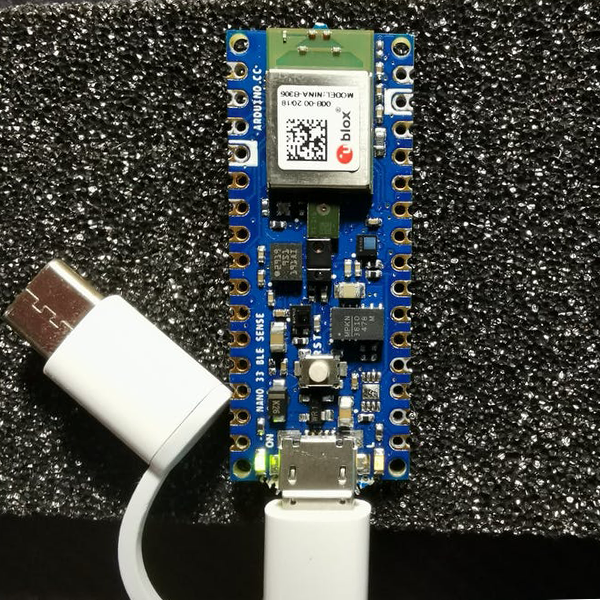 Ray Simar is taking his VIP Projects in a new direction. Project 979 will be comprised of three smaller projects listed below
Ray Simar is taking his VIP Projects in a new direction. Project 979 will be comprised of three smaller projects listed below- TinyML - Using Google's latest machine learning tools to design inference engines that can run on low-power, low-cost microcontrollers
- Embench DSP - Embench is a new initiative, led by David Patterson of Google, to create an industry-standard benchmark suite for the embedded processor space. Ray and his team have been asked to develop a new set of DSP benchmarks to become part of Embench.
- Hope-Simpson - A multidisciplinary effort to explore COVID-19 cases worldwide by applying modern tools to a 1990's concept.
Lead faculty: Ray Simar
- IoT Flood Sensor
-
 Led by Professor Gary Woods, IoT Flood Sensor helps model flood-water flows during heavy rainfall. Hurricane Harvey has shown that emergency response and evacuation require up-to-date information on which roads are passable. To address both these needs, we are developing an Internet of Things sensor network that measures street-flooding levels in Houston. The network runs entirely off-grid and reports data to the cloud via the cellular telephone network. Current work includes incorporating new types of water-level sensors, developing web databases, and building & maintaining prototypes. We have opportunities for PCB design, embedded programming, and web development in this VIP Project.
Led by Professor Gary Woods, IoT Flood Sensor helps model flood-water flows during heavy rainfall. Hurricane Harvey has shown that emergency response and evacuation require up-to-date information on which roads are passable. To address both these needs, we are developing an Internet of Things sensor network that measures street-flooding levels in Houston. The network runs entirely off-grid and reports data to the cloud via the cellular telephone network. Current work includes incorporating new types of water-level sensors, developing web databases, and building & maintaining prototypes. We have opportunities for PCB design, embedded programming, and web development in this VIP Project.Lead faculty: Gary Woods
- Next-gen Wearables
-
 Next-generation health wearables will be able to see below the skin, and will be able to measure both biology and behavior in ways that are considered impossible today. Join us on two ambitious large-scale efforts, PATHS-UP (pathsup.org) and "See below the skin" (seebelowtheskin.org). The research is at the cross-section of engineering, biology, and behavior.
Next-generation health wearables will be able to see below the skin, and will be able to measure both biology and behavior in ways that are considered impossible today. Join us on two ambitious large-scale efforts, PATHS-UP (pathsup.org) and "See below the skin" (seebelowtheskin.org). The research is at the cross-section of engineering, biology, and behavior.Lead faculty: Ashu Sabharwal
- RENEW
-
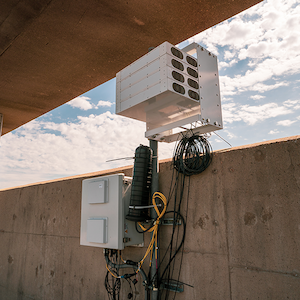 RENEW wireless (renew-wireless.org) is developing the world's first fully open-source 5G base-station platform being deployed as part of NSF National Wireless Testbeds. The research is at the cross-section of wireless, computer engineering, and computer science.
RENEW wireless (renew-wireless.org) is developing the world's first fully open-source 5G base-station platform being deployed as part of NSF National Wireless Testbeds. The research is at the cross-section of wireless, computer engineering, and computer science.Lead faculty: Ashu Sabharwal
- Rice Electric Vehicle (REV)
-
 The Rice Electric Vehicle club designs electric cars to compete in national events. We are developing a fully custom motor-control system to efficiently deliver two brushless DC hub motors for use in the car. We are also developing all the other electronic and software systems for the vehicle, including control, display, and lights/horn/wipers/safety. We have opportunities for people interested in circuit design, electronic fabrication, and embedded programming.
The Rice Electric Vehicle club designs electric cars to compete in national events. We are developing a fully custom motor-control system to efficiently deliver two brushless DC hub motors for use in the car. We are also developing all the other electronic and software systems for the vehicle, including control, display, and lights/horn/wipers/safety. We have opportunities for people interested in circuit design, electronic fabrication, and embedded programming.Lead faculty: Gary Woods
- Parallel Hardware Applications in Science and Technology (PHAST)
-
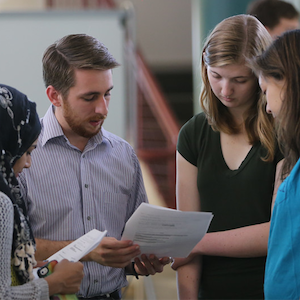 Parallel hardware and software can accelerate many applications in signal processing systems. The PHAST team is currently using FPGA and GPU accelerators for two application areas. One group is applying GPU technology to improve the performance of power amplifiers for wireless communication systems through digital pre-distortion. The second group uses FPGA technology for embedded machine learning for sensor networks with the Python on Zynq environment from Xilinx.
Parallel hardware and software can accelerate many applications in signal processing systems. The PHAST team is currently using FPGA and GPU accelerators for two application areas. One group is applying GPU technology to improve the performance of power amplifiers for wireless communication systems through digital pre-distortion. The second group uses FPGA technology for embedded machine learning for sensor networks with the Python on Zynq environment from Xilinx.Lead faculty: Joseph Cavallaro
- DISSECT: DIStrubuted Sensors, Effectors and Computers Team
-
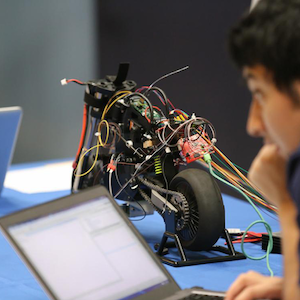 The game of golf has existed in its modern form since the 15th century, and one club stands alone: the putter. About half of golf shots are made with the putter. Putting is not easy – the putter swings slowly and with a very light force. It is incredibly challenging and frustrating. Even professional golfers often miss short putts. The DISSECT team aims to provide feedback to the golfer so that they can learn to precisely control the magnitude of the force that they apply to the golf ball.
The game of golf has existed in its modern form since the 15th century, and one club stands alone: the putter. About half of golf shots are made with the putter. Putting is not easy – the putter swings slowly and with a very light force. It is incredibly challenging and frustrating. Even professional golfers often miss short putts. The DISSECT team aims to provide feedback to the golfer so that they can learn to precisely control the magnitude of the force that they apply to the golf ball.Course: Not open for Spring 2021
Lead faculty: Ray Simar
- A Digital Cure for Epilepsy
-
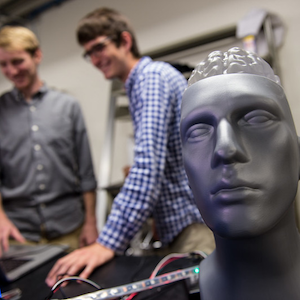 Epilepsy is the 4th most common neurological disease in the United States. Unfortunately, 30% of the patients don't respond well to traditional treatments like drugs. For those patients, the only permanent treatment is resection of the part of the brain whose hyperactivity is responsible for seizures. This method is invasive and carries high risk. By predicting seizures before its onset, doctors could act preventively with actions that include stimulation treatment. Rice University and the University of Texas Health Science Center worked together to develop algorithms that will optimize the development of an implantable device. The device will deliver low-frequency electrical stimulation to the seizure onset zone.
Epilepsy is the 4th most common neurological disease in the United States. Unfortunately, 30% of the patients don't respond well to traditional treatments like drugs. For those patients, the only permanent treatment is resection of the part of the brain whose hyperactivity is responsible for seizures. This method is invasive and carries high risk. By predicting seizures before its onset, doctors could act preventively with actions that include stimulation treatment. Rice University and the University of Texas Health Science Center worked together to develop algorithms that will optimize the development of an implantable device. The device will deliver low-frequency electrical stimulation to the seizure onset zone.Course: Project completed, no longer open
Lead faculty: Behnaam Aazhang
